meat cutting instructions beef
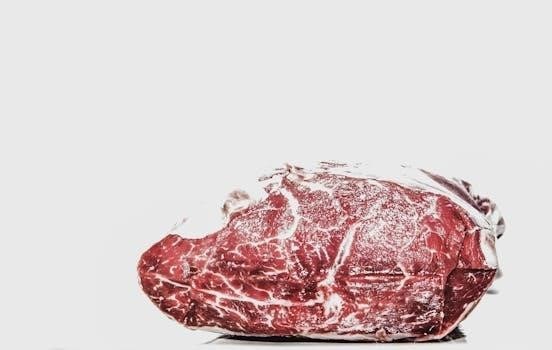
Understanding beef primal cuts is essential for identifying where your favorite steaks and roasts originate. These nine primal cuts serve as the basis for all retail beef cuts, providing a foundation for butchery practices.
Understanding the Concept of Primal Cuts
Primal cuts are the large, initial sections of beef separated from the carcass during butchering. These are fundamental divisions, forming the basis for all other retail cuts. Think of them as the main building blocks of a beef carcass, each possessing unique characteristics in terms of muscle structure, tenderness, and flavor. These primal sections are further broken down into sub-primal cuts, which are then portioned into steaks, roasts, and other familiar cuts. Understanding primal cuts is crucial for butchers and consumers alike, providing insight into the origin of different beef products and guiding cooking methods. The process begins by dividing the carcass into these large primal sections, each with specific qualities and uses. This division is a key step in the butchering process, allowing for the efficient utilization of the entire animal. It’s also the starting point for appreciating the diversity of beef cuts.
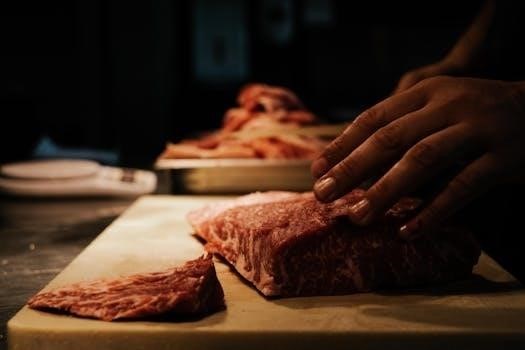
The Nine Beef Primal Cuts
The nine beef primal cuts include the chuck, rib, loin, round, flank, short plate, brisket, shank, and sirloin. These form the foundation for all other retail beef cuts.
Chuck⁚ Location and Sub-Primal Cuts
The chuck primal cut is located in the front of the cow, specifically at the base of the neck and extending into the shoulder area. It is one of the larger primal cuts, known for its rich flavor due to the muscle usage in that area. The chuck is further divided into several sub-primal cuts, each with its own characteristics and culinary applications. These sub-primal cuts include the beef ribs, which are bone-in and often used for braising. Another notable sub-primal is the top blade, which can be cut into flat iron steaks. The chuck roll is a large, versatile cut, great for slow cooking and roasts. The chuck also contains cuts ideal for stewing or grinding into ground beef, making it a highly economical and flavorful portion of the animal. Its location and composition result in varied textures and cooking possibilities, making it a staple in many cuisines.
Rib⁚ Location and Sub-Primal Cuts
The rib primal cut is situated directly behind the chuck, along the upper portion of the cow’s midsection. This area is renowned for its tenderness and marbling, making it a highly desirable cut. The rib primal is further divided into several sub-primal cuts, each offering unique culinary options. The most famous sub-primal is the ribeye, which can be prepared as individual steaks or as a roast. Another popular sub-primal is the prime rib, a large, bone-in roast known for its succulent flavor. Short ribs, also derived from the rib primal, are typically braised for a tender, fall-off-the-bone texture. The rib section is prized for its rich flavor and tender meat, making it suitable for grilling, roasting, and braising. These cuts are often considered premium due to their marbling and tenderness, resulting in a luxurious eating experience.
Loin⁚ Location and Sub-Primal Cuts
The loin primal cut is located behind the rib, extending along the upper back of the cow. This region is notable for its lean and tender muscles, yielding some of the most prized steaks. The loin is primarily divided into two sub-primal cuts⁚ the short loin and the sirloin; The short loin is famous for producing cuts like the porterhouse, T-bone, and strip steaks, all known for their tenderness and fine texture. The sirloin, positioned further back, is still tender but with slightly more muscle. From the sirloin, we get top sirloin steaks and tri-tip roasts. The loin is ideal for grilling, broiling, and pan-searing due to its inherent tenderness. The relatively lower fat content in the loin makes it a leaner option, allowing for a flavorful and satisfying meal. These sub-primal cuts are often highly valued for their versatility and lean profile.
Round⁚ Location and Sub-Primal Cuts
The round primal cut is located at the rear of the cow, encompassing the hind leg and rump area. This large section is known for its lean muscle and is often less tender than the loin or rib. The round is divided into several sub-primal cuts, including the top round, bottom round, and eye of round. These are typically used for roasts, stews, or ground beef. The top round is the most tender of the round cuts, ideal for roasting or thinly sliced for deli meat. The bottom round, being tougher, benefits from slow cooking methods like braising. The eye of round is very lean and best used for roasting or slicing for sandwiches. Due to its lean nature, the round requires careful cooking to prevent dryness; methods like slow cooking and marinating are highly recommended. This primal is versatile for various cooking needs.
Flank⁚ Location and Sub-Primal Cuts
The flank primal cut is situated below the loin and sirloin, on the abdominal area of the cow. This cut is known for its long, flat shape and flavorful, though somewhat tough, muscle fibers. The primary sub-primal cut derived from the flank is the flank steak, known for its strong grain and rich taste. Flank steak is best when marinated and cooked to medium rare, then sliced thinly against the grain for maximum tenderness. Other sub-primal uses include ground beef. Flank is not as tender as other cuts, making it suitable for dishes where the flavor profile is more important than melt-in-your-mouth tenderness. Slow cooking or braising can also break down the tougher fibers, making the flank meat very palatable. It’s a popular choice for stir-fries and fajitas.
Short Plate⁚ Location and Sub-Primal Cuts
The short plate primal cut is located beneath the rib primal, along the belly of the cow. This cut is known for its rich flavor due to its high fat content and is often less tender than other areas. Key sub-primal cuts from the short plate include the short ribs, which are popular for braising, and the skirt steak. The skirt steak, a thin, flavorful cut, is commonly used in dishes such as fajitas and stir-fries. Another sub-primal cut from this area is the hanger steak, valued for its intense beefy flavor. Short plate is also sometimes used for ground beef. Due to the toughness of the muscle fibers, slow cooking methods are generally recommended for the short plate, ensuring that the meat becomes tender and juicy. It’s a versatile cut that benefits from marinating and low-and-slow cooking techniques.
Brisket⁚ Location and Sub-Primal Cuts
The brisket primal cut is situated in the breast section of the cow, specifically below the chuck. This large cut is composed of the pectoral muscles and is known for its toughness due to the amount of connective tissue. The brisket is typically divided into two sub-primal cuts⁚ the point cut, also known as the deckle, which is fattier and more flavorful, and the flat cut, which is leaner and more uniform in shape. The point cut is often used for making flavorful, juicy pulled beef. The flat cut is commonly used for slicing or corning to make corned beef. Slow cooking methods, such as smoking or braising, are essential for breaking down the tough connective tissue in brisket, resulting in tender and succulent meat. It is a popular choice for barbecuing.
Shank⁚ Location and Sub-Primal Cuts
The shank primal cut is located in the leg portion of the cow, both in the front and hind legs. The front shank is part of the foreshank primal, while the hind shank is part of the round. This cut is characterized by its high amount of connective tissue and bone, making it a tough and flavorful cut. The shank is typically not divided into many sub-primal cuts, though it may be portioned into smaller cross-sections. These cross-sections are often referred to as shank slices or osso buco. Due to its toughness, the shank requires long, slow cooking methods to break down the connective tissue. This process transforms the meat into a tender and rich option. It’s commonly used in soups, stews, and braises, where its deep flavor can fully develop, enriching the broth and overall dish.
Sirloin⁚ Location and Sub-Primal Cuts
The sirloin primal cut is positioned at the rear of the animal, between the loin and the round. It’s known for its good balance of tenderness and flavor, making it versatile for various cooking methods. Key sub-primal cuts derived from the sirloin include the top sirloin, bottom sirloin, and tri-tip. The top sirloin is often used for grilling and roasting, celebrated for its lean nature and beefy taste. The bottom sirloin is typically utilized for roasts or ground beef due to its slightly tougher texture. Tri-tip, a triangular muscle from the bottom sirloin, is popular for grilling and smoking, offering a rich flavor profile. These sub-primal cuts provide diverse options for consumers, ranging from quick-cooking steaks to flavorful roasts, each with its unique cooking suitability.
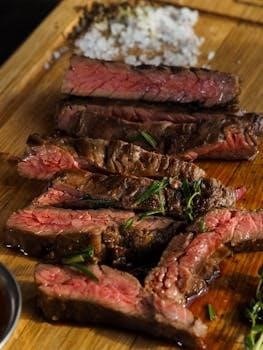
Sub-Primal Cuts and Their Uses
Sub-primal cuts are the secondary divisions of the larger primal cuts, each possessing unique characteristics that dictate their best culinary applications. For instance, the ribeye steak, a sub-primal from the rib, is ideal for grilling due to its rich marbling. The chuck roll, from the chuck, is often slow-cooked because it benefits from long, low heat, resulting in tender textures. Tenderloin, a sub-primal from the loin, is known for its exceptional tenderness, perfect for quick searing or roasting. The brisket, often used for smoking and braising, breaks down beautifully with extended cooking times. Similarly, the flank steak, known for its grain, is best for quick, high-heat cooking. The variety of sub-primal cuts allows for diverse culinary explorations, each tailored to specific cooking methods for optimal results.
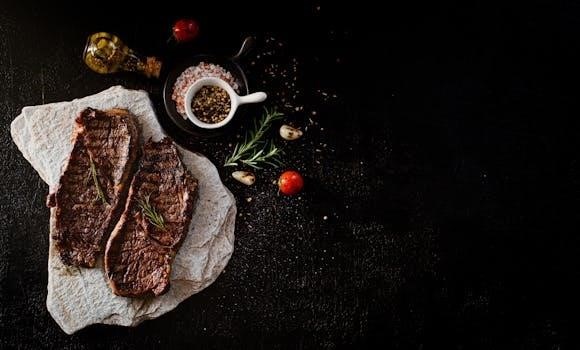
Beef Cuts Chart and Diagrams
Beef cuts charts provide visual guides illustrating how primal cuts are divided into sub-primal cuts. Diagrams enhance this understanding, offering a comprehensive overview of beef anatomy and butchery practices.
Using Charts for Cutting
Beef cut charts are invaluable tools for butchers and home cooks alike, offering a detailed breakdown of the various primal and sub-primal cuts. These charts typically display the anatomical location of each cut, along with its corresponding name and often include recommended cooking methods. A butcher’s chart can further specify IMPS/NAMP numbers, which are industry-standard codes for each cut, ensuring consistency in ordering and processing. These charts are not only useful for understanding the relationship between different cuts but also in selecting the right cut for a specific recipe or cooking technique. They also aid in recognizing the characteristics of each cut, such as its tenderness, fat content, and flavor profile, which helps in making informed decisions during meal planning. Furthermore, a chart enables one to explore different sub-primal options, expanding culinary horizons and ensuring consistent results. A well-designed chart is an indispensable resource, improving accuracy and efficiency in the art of butchery.
Diagrams for Visual Understanding
Diagrams play a crucial role in visually representing the complex structure of beef primal and sub-primal cuts. These diagrams illustrate how a side of beef is divided into its major sections, making it easier to understand the anatomical relationships between different cuts. They provide a clear picture of where each cut is located on the carcass, helping both butchers and consumers visualize the process of meat cutting. With the help of detailed diagrams, one can easily distinguish between cuts such as the chuck, rib, loin, round, and so on, by their location on the animal. These diagrams often include labels for both primal and sub-primal cuts, offering a quick reference guide for identification. Visual learning is extremely useful for a better understanding of the entire process. Furthermore, these diagrams can be paired with beef cut charts to enhance comprehension of the written information, which helps in making better cooking choices, and improving butchery skills. Therefore, diagrams provide an important aspect of visual understanding.
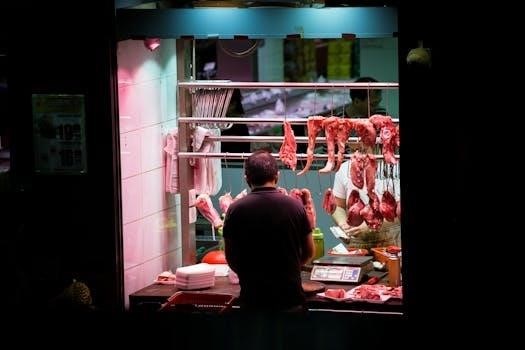
Cooking Methods for Different Cuts
The appropriate cooking method for a specific beef cut largely depends on its location, muscle composition, and tenderness. For example, tougher cuts like those from the chuck or round, benefit greatly from slow cooking methods like braising or stewing. These techniques use moist heat to break down connective tissues, resulting in tender and flavorful meat. Conversely, more tender cuts like those from the rib or loin are best suited for dry-heat methods such as grilling, roasting, or pan-searing. This preserves their tenderness and enhances their natural flavor. Cuts like the brisket, which have a significant amount of connective tissue, are perfect for smoking, which allows the meat to become extremely tender over long period of time. Understanding the best cooking method for each cut allows us to achieve the best texture, flavor, and overall result of the dish. It is essential to consider the characteristics of each cut to ensure the most enjoyable and successful cooking outcome. Therefore, selecting the correct cooking method is key for maximizing the eating experience.